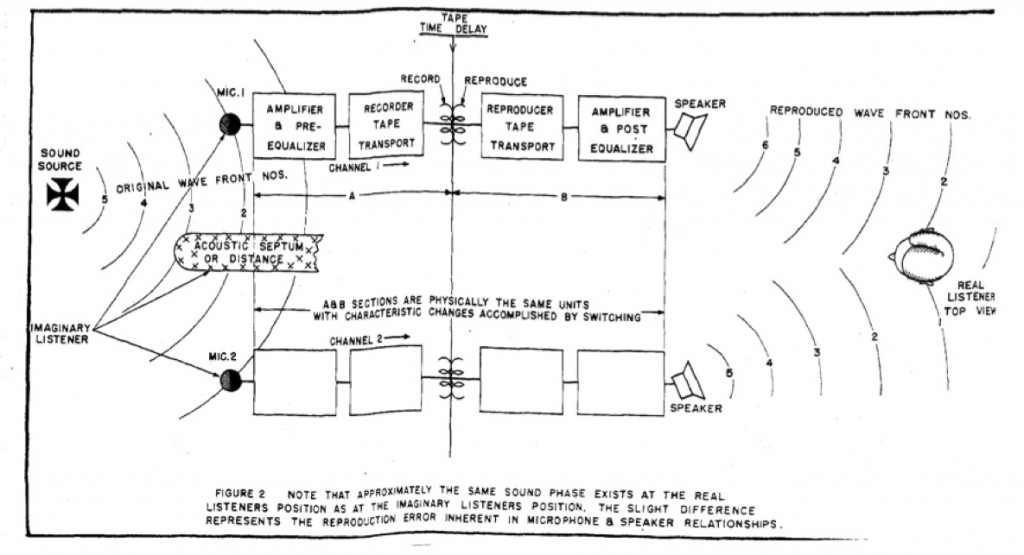 Download a nine-page piece first presented in 1952 by one Otto Bixler of the Magnecord Corporation. Bixler describes Magnecord’s early work in the field of stereophonic recording and reproduction.
Download a nine-page piece first presented in 1952 by one Otto Bixler of the Magnecord Corporation. Bixler describes Magnecord’s early work in the field of stereophonic recording and reproduction.
DOWNLOAD: BinauralRecordingSystem_Bixler
Thank you to a very helpful long-time contributor for sending this piece in. This article was originally published right at the dawn on the stereo era, and it’s interesting to read some early speculation about the promise/usefulness that stereo sound offered. I’ve been thinking quite a bit about stereo effects recently, as I picked up a Calrec Soundfield Mark IV earlier this season. It’s currently being serviced, but look forward to some interesting experiments and reports on that exotic piece soon.
5 replies on “Interesting Binaural article from 1952”
Hi Chris:
Some of the very experiments described in this report were recorded by Magnecord dealer and enthusiastic binaural recordist Bert Whyte. Whyte’s early stereo experimenting was partially described previously on your website:
https://www.preservationsound.com/?p=4465
Emory Cook probably used something with staggered heads, I’d guess a Magnecorder, for his early binaural recordings, including his twin-groove LP records. Cook Laboratories was of course another cutting-edge audio venture based in Connecticut.
The earliest mention I’ve seen of a stacked-head (two tracks within one head assembly) binaural recorder was the 1953 first edition of the Ampex 350-2:
http://www.ilk.org/~ppk/Manuals/Ampex_350/Ampex_350-2_details.pdf
Enough Magnecord-style staggered-head 2-track machines were sold that some companies, notably RCA and Concertapes, released their first mass-duped stereo product in both staggered-head and “in-line” (stacked head) formats. Concertapes was still issuing staggered-head tapes in 1956, I have a few of them. I think once Ampex put the push on for stacked-head multi-track in the mid-50’s, the staggered-head format died off. Ampex released their Model 612 “Stereophony Tape Phonograph” play-only deck in 1955, right about the time the major record labels jumped into the 2-track tape market. Smaller labels like Livingston and Concertapes had product in the market in early 1955 or late 1954.
Another interesting discussion is the difference between “binaural” 2-channel recordings and “stereo” 2-channel recordings. But that’s another topic for another posting.
— Tom Fine
great info Tom thank you! re: binaural vs stereo: I always had the impression that binaural audio was a specific subset of stereo audio in which the stereo information supposedly imitates the specific phase shift and intensity variance of healthy human (two-eared) hearing. Does this sounds about right or is there more to it than that?
Binaural usually refers to recordings made with a dummy head mic and intended for headphone listening. Such recordings are usually not all that great for regular stereo listening on speakers.
Bert Whyte was a frequent contributor to the old audio magazines and is not to be confused with the eccentric Stan White, another frequent contributor.
He’s still at it too.
http://www.stan-white.com/
Actually, binaural recording theory goes back to before dummy-head setups, although in the modern setting most binaural recordings are made with dummy heads.
Blumlein’s original theories about 2-channel mic technique and recording were called binaural because he intended them for headphone listening (ie two separate speakers near each ear and not in front of the head). The early Bell Labs research on stereophony found that humans preferred 3-channel reproduction from speakers place at some distance from the head specifically because of the fact that the human head produces varying degrees of “hole in the middle.” Modern full-range playback and modern speakers, when placed correctly, overcome these issues for the most part, but some people are still diehard binauralists. David Chesky just recently released a new series of what he calls headphone/speaker compatible binaural recordings.
The other extreme, which I call “mono with a dash of stereophony” is the typical rock album mix of the last 40 years. Almost all energy is in the center almost all of the time, with a bit here or there to one of the other channels. A notable exception are the first few Van Halen records, which Ted Templeman mixed pretty much live and where Eddie VH did very little guitar overdubbing. So his guitar is hard left, Michael Anthony’s bass is hard right, the drums are spread across and David Lee Roth is howling in the center, all mushed up with plenty of reverb. More typical is to have wide-stereo drums but with the main beat dead center, bass dead center and guitars either dead center or near center. Vocals, except for the occasional choral accent, are also dead center. That, by definition, is near-monophony.
There’s a legit argument, in my opinion, that the only music that highly benefits from stereophony is orchestral classical music and big-band jazz. Small-group jazz thrived for decades with great mono mixes (and great skill at sound-balancing and arranging by the musicians themselves). Most of the classic, golden era rock hits were heard in mono and won their gold records as mono AM radio singles. More complex rock, which is really studio sound-painting, like late Beatles, most Pink Floyd, Yes, that kind of stuff, does benefit greatly from stereo, but check out the Beatles mono box set. Even the White Album sounds damn good in mono, more punchy and more about songs instead of sounds.
Lots of tangents there!
— Tom Fine
I have in my collection, a good host of RCA, Livingston and Concert Hall Society reels processed for use with the Staggered playback units.
I also have constructed a tape machine with the staggered head arrangement to play back these early tapes and the quality was indeed there.